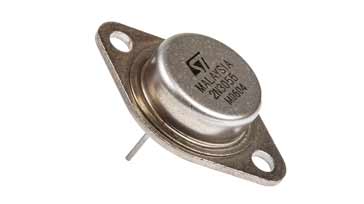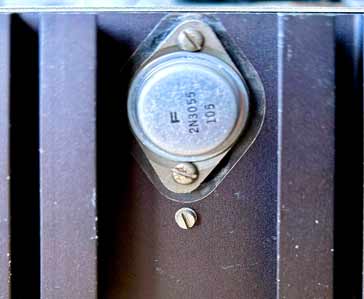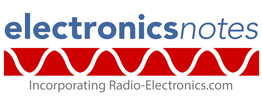Home » Component data » Transistor data » this page
2N3055 Transistor Data
Key transistor data for the 2N3055 power transistor including key electrical parameters, pinout, package type and many other key transistor datasheet details.
The 2N3055 is a rugged power transistor widely used for amplifier and power switching circuits. It was a popular device used in many power audio amplifiers.

The device comes with complementary device, the MJ2955 enabling class B operation for linear amplifiers.
Both devices are still widely available and manufactured by a variety of manufacturers.
Key details and performance parameters for the 2N3055 transistor.
| Transistor Datasheet Parameters & Data |
|
|---|---|
| Parameters | Datasheet Details |
| Transistor type | NPN silicon power transistor |
| Package type | TO3 |
| VCBO max (V) | 100 |
| VCEO max (V) | 60 |
| VEBOmax (V) | 7 |
| IC max (A) | 15 |
| TJ Max °C | 200 |
| PTOT W | 115 |
| fT min (MHz) | 2.5 |
| COB | |
| hfe | 20 - 70 |
| IC for hfe | 4 A |
| Similar / equivalents | |
Outline:
Pinout:
Explanation of transistor parameters
| Parameter | Explanation |
|---|---|
| VCBO Max | Maximum collector-base voltage with emitter open circuit . |
| VCEO Max | Maximum collector-emitter voltage with base open circuit. |
| VEBO Max | Maximum emitter-base voltage with collector open circuit. |
| VCEsat (included where applicable) | The voltage drop across the collector-emitter when the transistor is fully saturated (acting as a closed switch). |
| IC Max | Maximum collector current. |
| Parameter | Explanation |
|---|---|
| TJ | Maximum junction temperature. |
| PTOT Max | Maximum device dissipation normally in free air at 25°C unless other conditions indicated. |
| fT Min | Minimum cutoff frequency at which the current gain in a common emitter circuit falls to unity. |
| COB Max | Maximum collector capacitane, normally measured with emitter open circuit. |
| hFE | DC current gain for HFE at IC. [Note hfe is the small signal gain and although this may be slightly different, the transistor current gain will vary considerably from ne transistor to the next of the same type.] |
| PTOT Max | Maximum device dissipation normally in free air at 25°C unless other conditions indicated. |
These are the main transistor parameters that have been included in our list. There are others, but these help quantify the main elements of the performance of the transistor.
Please note, that the data given is the best estimate we can give within a tabulated summary of this nature. Parameters also vary between manufacturers. Electronics Notes cannot accept any responsibility for errors, inaccuracies, etc, although we do endevaour to ensure the data is as accurate as possible.
Notes and supplementary information
This silicon power transistor was for many years the standard power transistor for power supplies, audio amplifier output stages and for many other circuits. It was a great workhorse.
• Availability & sources
The 2N3055 is available from a number of stockists and electronic component distributors many of which are given in the table below.
2N3055 Component Distributor, Stock and Pricing
The 2N3055 transistor is widely manufactured these days and can be obtained through a variety of distributors.
Not only is it manufactured by some of the mainstream manufacturers, but also a large number of secondary companies as well.
The technology is old, and it is easy to manufacture, and accordingly it is easy for smaller manufacturers to pick the fabrication techniques up.
• Mounting the 2N3055
As the collector connection is the case to provide adequate heat-sinking, special insulation kits were available for mounting these power transistors onto a heatsink. A thin mica or similar washer shaped to the outline of the transistor and insulating washers for the screw connections were available.
It was also standard practice to place a small amount of silicon grease on either side of the washer to ensure good thermal contact to the heatsink.
• 2N3055 story
The 2N3055 was designed by the silicon engineering group within RCA in the early 1960s.
In view of its cost, performance and reliability and the fact that it was one of the first silicon power transistors, it became an industry standard.
The transistor was second sourced by other manufacturers; Texas Instruments listed a single-diffused mesa version of the device in an August 1967 datasheet. Today, it is manufactured by a variety of companies who are able to ensure its continued supply and use.
The 2N3055 remains very popular as a series pass transistor in linear power supplies and is still used in for medium-current and high-power circuits generally, including low frequency power converters.
The device was used in many audio power amplifiers, but its rather low fT means that even at 20 kHz there are uses with frequency response and the phase shift that occurs as the frequency response falls.
• Modern versions
As the T03 can is now old technology some people are using a TO220 version of the transistor. Often designated the MJE3055, it has slightly less power and current handling capability, but it is easier to handle and mount.
• Applications
The 2N3055 was widely used in many electronic circuit designs that needed a power output device. The handling capability of the transistor made it ideal for many different designs.
Typically the device was mounted on a heatsink - the TO3 package that is used, is designed for this type of mounting and this enables the heat dissipated to be removed without the transistor overheating.

The voltage and power handling capability meant that it was an ideal device as the series pass transistor.
 Written by Ian Poole .
Written by Ian Poole .
Experienced electronics engineer and author.
Return to Component Data menu . . .




